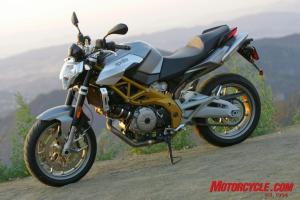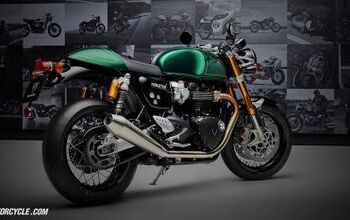2008 Aprilia SL750 Shiver Review - Motorcycle.com
Get the Flash Player to see this player.
Let's face it, more than 90% of supersport bikes never set tires on a racetrack or trackday, so for these riders, it's senseless to be at the controls of a sportbike that doesn't make serious power until five-digit revs and folds its rider unmercifully. The Shiver provides strong low-rpm power and comfy ergos yet without the stigma of a lowly budget bike.
With an MSRP of $8,999, the SL750 approaches the price of a supersport, but it provides a host of real-world amenities the racing-driven bikes don't offer, and it's a relative bargain in terms of Italian motorcycles.
The chassis of this new naked bike consists of a stylish tubular-steel trellis frame joined to beefy aluminum side plates. The aluminum theme continues its way rearward with a cool alloy swingarm. Its overall appearance is a sharp and modern take on a sporting naked bike, a result of designer Miguel Galuzzi, the man who originally penned the iconic Ducati Monster and who today heads the Aprilia Style Center. In addition to our Fever Silver test unit, it's also available in Code Orange.
At the core of the Shiver is an all-new 750cc V-Twin engine, almost identical to that of the recently introduced Dorsoduro that our pal Yossef tested a few weeks ago. Arranged in 90-degree vee angle for smoothness, the chain- and gear-driven DOHC motor is said to be the world's first production bike to feature ride-by-wire technology. While Yamaha has had electronic control of its throttle opening on its R6 and R1 sportbikes, Aprilia is the first to also have bits-and-bytes control of throttle closure. The system takes into account multiple parameters (rpm, gear, throttle rate, atmospheric pressure and temperature) to offer optimal response from the twin throttle bodies.
Climbing aboard the Shiver is a welcoming experience. It has a very natural riding position, with a tapered aluminum handlebar reaching out for your hands, as do adjustable levers. Its seat is quite high (31.9 inches), partially due to the underseat exhaust, preventing the feet attached to a 32-inch inseam to touch the ground flat-footed. The seat's sloping layout and narrow forward section bring it as close to the ground as possible, but they also somewhat hinder long-range comfort. Footpegs are set further forward than expected for a sports roadster like this, but, even so, they prove to be not easy to drag.
'With a shortish low gear and strong low-end power, the SL in its name might stand for See-ya Later.'
Firing up the SL750 reveals a rumbly yet smooth exhaust note not dissimilar to a Ducati mill. In an effort to extract the most pleasing tones, Aprilia contracted Alfa Romeo to run computer simulations of various exhaust layouts. What they came up with was a two-into-one undertail system in which the canister under the seat is shaped like an inner fender. The futuristic exhaust outlets polarize opinions of style, but the design is functional in that not much heat is radiated to the rider.
The pull of the Shiver's hydraulic clutch is a bit heavy, but a rider quickly forgets about it once underway. With a shortish low gear and strong low-end power, the SL in its name might stand for See-ya Later. Thrust is decent at 3500 rpm, and stronger than you might imagine at 4500 revs when it picks up speed smartly. There's in excess of 39 ft-lbs of torque available from as low as 3800 rpm all the way to redline, peaking at 7600 revs with 45.0 ft-lbs.
But this bottom-range grunt has its price. Once past the "Hey, this thing is kinda quick" feeling up to 7K rpm, thoughts turn to "Does this thing have a rag in its airbox?" as revs climb to a soft rev limiter at 10K rpm. Its 76.0-hp peak at 9300 rpm won't be frightening any Ducati 749 owners. We wonder if our bike was in its best state of tune, as horsepower and torque readings from the Dynojet are down 20% and 25%, respectively, from Aprilia's crankshaft claims. A typical reduction from a chain-driven bike is between 10% and 14%.
Continuing the electro-wizardry theme, the Shiver has three different maps that are switchable via the starter button. The default map is Sport, and it's the most aggressive. Switch over to Tour and you'll find smoother transitions from a closed throttle but no decrease in power measured on the dyno. Rain mode severely knocks down engine output to best handle slippery situations, with a peak yield of 62.5 horses at 9500 rpm. If you're riding on anything tackier than snot, you'll not want to be in Rain mode.
With the Shiver's commanding riding position, the bike bends in to corners easily, despite a lazyish 25.7-degree rake and a moderate 109mm trail. Its upright handlebar gives good arm leverage to also overcome a 56.7-inch wheelbase, steering the bike adroitly if not ultra-quickly. This makes for stable, non-twitchy handling at all speeds, aided by a respectable 417-lb claimed dry weight.
Brakes appear to be high-spec, using 4-piston radial-mount calipers and the same 320mm discs used on the Mille and Tuono sportbikes. But despite braided steel lines, we were disappointed with excessive lever travel before actuating, and when they did, they bit with slight abruptness. A 245mm rear disc with single-piston caliper works seamlessly.
We rode the Shiver in all types of environments, from city commuting to freeway bombing to backroad blasting, and we were impressed with the overall competence of this naked roadster.
It's skinny between the knees, enhancing its nimble feeling. Its stylish and modern headlight deflects some wind to make 80-mph cruising palatable, and there's enough room on the seat to move rearward, rotating the body forward for better aero. Both sets of footpegs are rubber-covered to damp vibration, and a wide pillion seat with convenient grab rails means passengers are welcome. A good view from the mirrors keeps a steady eye on your six.
The red side of the Shiver's ledger is quite sparse. Along with a merely adequate suspension, the SL's gearbox is less than stellar. We found a few false neutrals with an un-firm boot, both between 3 and 4 and 4 and 5. Riders who like to go many miles between fill-ups might complain about a smallish 4.2-gallon fuel tank. The SL750 averaged 36 mpg in our hands, giving it a range of about 150 miles.
For some riders in the market for a $9K sports roadster, the purchase decision might be determined by how you feel about 76 horsepower. If that, combined with a very healthy torque curve, meets your requirements, the feature-packed Shiver has plenty of positive attributes that deserve your attention.
It's a sporty bike, not really a sportbike, and it's a better choice for a street-only rider who might otherwise choose a 600cc sportbike. Best of all, the SL does it in handsome style and without asking for comfort compromises.
| The Perfect Bike For... | ||
| A rider who wants something sporty and cool without the compromises of a pure sportbike. | ||
| Highs: | Sighs: | |
| Italian style Mellifluous sounds Versatile yet cool | Soggy up top for a liquid-cooled 750cc V-Twin Rear suspension merely adequate Gearbox could use some slickening | |
Duke's Duds
- Akuma V2 Stealth helmet
- Alpinestars Stunt jacket
- Shift Vertex gloves
- Shift Torque pants
- Icon boots
More by Kevin Duke




































Comments
Join the conversation